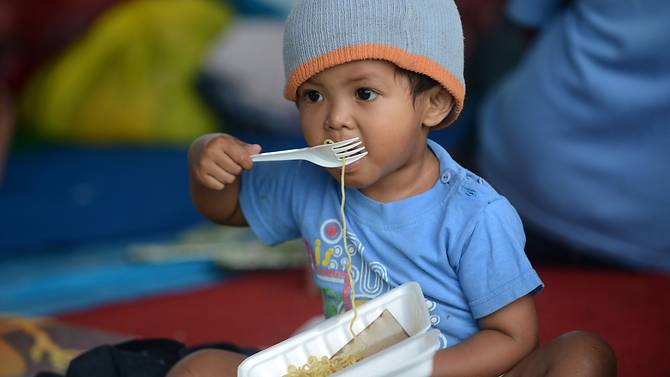Food aid, face masks dispatched to Bali as 57,000 flee volcano
 |
| A child eats inside an evacuation centre in Klungkung regency, on the Indonesian resort island of Bali. Mount Agung has been shaking since August and threatening to erupt for the first time in more than 50 years. (Photo: AFP/Sonny Tumbelaka) |
Mount Agung, about 75 kilometres from the Indonesian tourist hub of Kuta, has been rumbling since August, threatening to erupt for the first time since 1963.
"The chance that an eruption will happen is quite big. But it cannot be predicted when it will happen," Sutopo Purwo Nugroho, spokesman for the disaster mitigation agency, said.
The increased frequency of tremors shows the magma continuing to move towards the surface, with the mountain entering a "critical phase", the spokesman said.
The Indonesian Center for Volcanology and Geological Hazard Mitigation said there has been an increase in volcanic tremors, with a total of 564 recorded on Monday (Sep 25).
Evacuees have packed into temporary shelters or moved in with relatives. Some 2,000 cows have also been evacuated from the flanks of the volcano.
Speaking in Klungkung district, President Joko Widodo told evacuees the government would do its best to reduce economic losses incurred during the evacuation.
"It is not easy to handle a volcanic eruption because there is no certainty when it's going to happen, or if it's going to happen at all," he said.
"I ask everybody near Gunung Agung to listen to the officials, the governor, and the mayor's instruction so we can all minimise the impact of this volcano."
Balinese residents, international NGOs and the government have begun organising aid.
Vehicles filled with noodles, mineral water and blankets have been sent to the evacuation centres, while residents around the island have been collecting donations for those affected.
Bali's "sister village" programme and tradition of communal assistance means evacuees have been able to stay in villages outside the danger zone.
Around 62,000 people lived in the danger zone prior to the evacuations, according to the disaster mitigation agency.
I Ketut Subandi, head of logistics at the village of Tana Ampo, said basic food items like rice, instant noodles, cooking oil and water were most needed.
"This morning we were worried because we had limited rice supply, but now we have received more rice stocks from donors," Subandi said.
Indonesia's national disaster agency has dispatched 640,000 face masks, 12,500 mattresses, 8,400 blankets, 50 tents, and has a budget of US$75,000 for assistance.
The central government has set aside a relief fund of nearly US$150 million in case of an eruption.
Officials announced the highest possible alert level on Friday due to the increasing volcanic activity, and told people to stay at least nine kilometres away from the crater.
"Our preparedness will be the key for the mitigations of volcanic risks," Devy Kamil, a senior official at Indonesia's Center for Volcanology and Geological Hazard Mitigation, told AFP.
Trekking tours on the mountain have been cancelled by operators but officials have otherwise been at pains to assure tourists the island is safe.
The airport in Bali's capital Denpasar, through which millions of foreign tourists pass every year, has not been affected, but several countries including Australia and Singapore have put out a travel advisory.
Mount Agung is one of more than 120 active volcanoes extending the length of Indonesia, which straddles the Pacific Ring of Fire.
It last erupted in 1963, killing nearly 1,600 people and sending ash as far as the capital Jakarta.
What the stars mean:
★ Poor ★ ★ Promising ★★★ Good ★★★★ Very good ★★★★★ Exceptional
Latest News
More News
- 72 nations sign landmark Hanoi cybercrime convention (October 26, 2025 | 18:00)
- UN Secretary-General commends Vietnam’s global leadership (October 26, 2025 | 09:00)
- APEC finance ministers convene to tackle regional challenges (October 22, 2025 | 17:31)
- Rewiring global trade: ASEAN’s rise as supply chain hub (October 17, 2025 | 11:40)
- Vietnam attends first World Nuclear Week Forum in Russia (September 26, 2025 | 10:50)
- Vietnam attends 69th session of IAEA General Conference (September 16, 2025 | 10:00)
- ADB, WB pledge over 12 billion USD for ASEAN power grid, renewable energy projects (August 15, 2025 | 14:18)
- Lowy Institute proposes AI-based tobacco control solutions for ASEAN (August 15, 2025 | 14:14)
- Cloud computing policy to position Malaysia as regional hub by 2030 (August 15, 2025 | 14:11)
- Thailand, Cambodia suffer numerous cyber attacks (August 05, 2025 | 16:19)


















 Mobile Version
Mobile Version